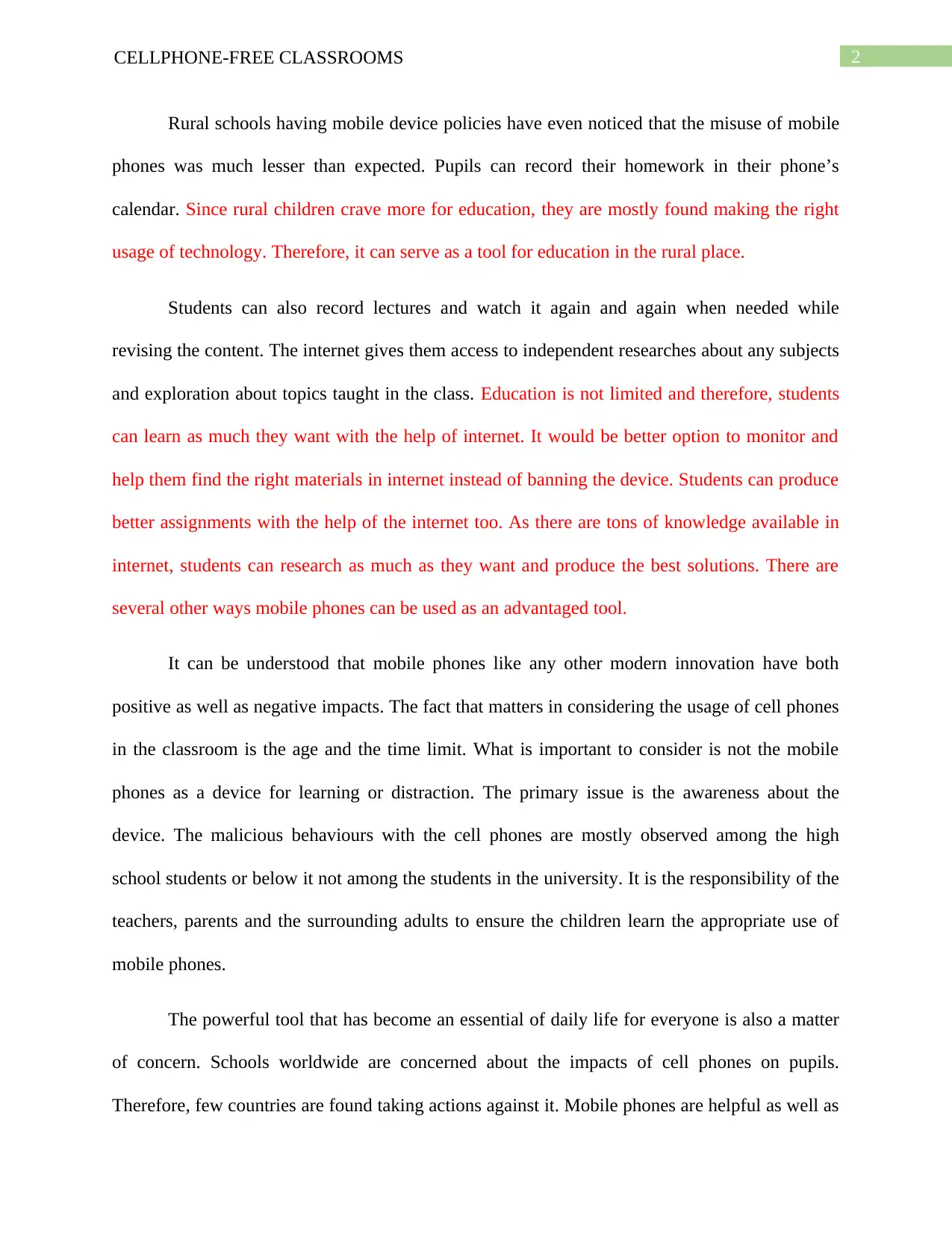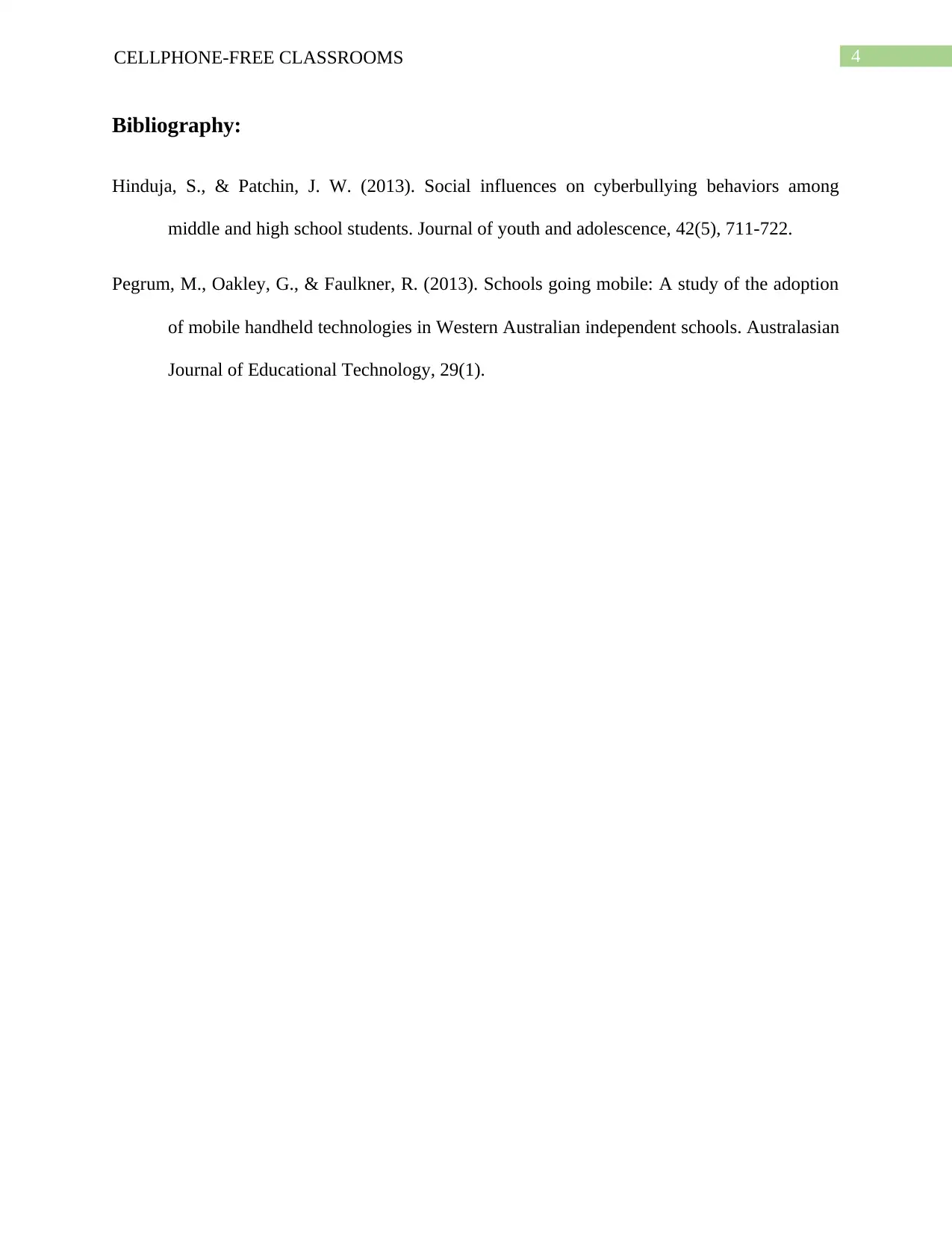Cell Phone-Free Classrooms: Advantages and Disadvantages for Students
VerifiedAdded on 2021/11/18
|5
|934
|163
Essay
AI Summary
This essay delves into the contentious issue of cell phone usage in classrooms, specifically focusing on post-secondary students. It presents arguments for and against the implementation of cell phone bans, drawing parallels to France's country-wide prohibition. The essay explores the potential of mobile phones as tools for independent study, highlighting their capabilities as powerful computers and their role in providing access to information and resources. It also acknowledges the importance of considering age and time limits when evaluating cell phone usage, and emphasizes the need for awareness and guidance to promote responsible use. The essay concludes by suggesting that education on the advantages and disadvantages of mobile phones is crucial, advocating for a balanced approach to address the impact of cell phones on pupils.

Running head: CELLPHONE-FREE CLASSROOMS
CELLPHONE-FREE CLASSROOMS
Name of the student:
Name of the university:
Author note:
CELLPHONE-FREE CLASSROOMS
Name of the student:
Name of the university:
Author note:
Paraphrase This Document
Need a fresh take? Get an instant paraphrase of this document with our AI Paraphraser

1CELLPHONE-FREE CLASSROOMS
Cell phones in class are one of the most discussed topics among school teachers, parents
and school officials. Often monitoring and controlling cell phones become hard for the teachers.
Also, in today’s world when every family members are working, cell phones become an essential
tool for parents to contact their children. This essay argues on the ban of cell phones in
classrooms as to reconsider the logic behind France’s country-wide prohibition of cell phones.
The essay primarily focuses on the post-secondary students.
No, it is a tool for independent study: Along with pen, pencil, notebook the presence of
mobile phones in the classroom has become increasingly common. Mobile phones are a highly
potent tool that can act as a lethal weapon in class. Mobile phones with access to the internet can
work like powerful computers. It is disappointing if a school that fails to provide modern IT
facilities ignore the capabilities of the small device. Schools that are run with low funds may find
this as an opportunity to bring the technology in class and make use of it.
With the help of the internet, these phones can be used in the classroom as a source of
independent study. It is even a device that student can trust and not leave hard works in the
school. It is common is school to be competitive and not wanting to share notes or study
materials. Often students try to present the best of their results with intense researches and
leaving the school laptop in school gives scope for other students to copy or cheat. Mobile
phones in that case are a suitable device that students can trust and keep with themselves.
Provided the technology available in the mobile phones, the GPS has been found a useful
tool for the geography students. Students would find it interesting when they can have closer
view of things they learn in schools. It is precisely the concept high infrastructure schools are
bringing in order to make studies more interesting and fun.
Cell phones in class are one of the most discussed topics among school teachers, parents
and school officials. Often monitoring and controlling cell phones become hard for the teachers.
Also, in today’s world when every family members are working, cell phones become an essential
tool for parents to contact their children. This essay argues on the ban of cell phones in
classrooms as to reconsider the logic behind France’s country-wide prohibition of cell phones.
The essay primarily focuses on the post-secondary students.
No, it is a tool for independent study: Along with pen, pencil, notebook the presence of
mobile phones in the classroom has become increasingly common. Mobile phones are a highly
potent tool that can act as a lethal weapon in class. Mobile phones with access to the internet can
work like powerful computers. It is disappointing if a school that fails to provide modern IT
facilities ignore the capabilities of the small device. Schools that are run with low funds may find
this as an opportunity to bring the technology in class and make use of it.
With the help of the internet, these phones can be used in the classroom as a source of
independent study. It is even a device that student can trust and not leave hard works in the
school. It is common is school to be competitive and not wanting to share notes or study
materials. Often students try to present the best of their results with intense researches and
leaving the school laptop in school gives scope for other students to copy or cheat. Mobile
phones in that case are a suitable device that students can trust and keep with themselves.
Provided the technology available in the mobile phones, the GPS has been found a useful
tool for the geography students. Students would find it interesting when they can have closer
view of things they learn in schools. It is precisely the concept high infrastructure schools are
bringing in order to make studies more interesting and fun.

2CELLPHONE-FREE CLASSROOMS
Rural schools having mobile device policies have even noticed that the misuse of mobile
phones was much lesser than expected. Pupils can record their homework in their phone’s
calendar. Since rural children crave more for education, they are mostly found making the right
usage of technology. Therefore, it can serve as a tool for education in the rural place.
Students can also record lectures and watch it again and again when needed while
revising the content. The internet gives them access to independent researches about any subjects
and exploration about topics taught in the class. Education is not limited and therefore, students
can learn as much they want with the help of internet. It would be better option to monitor and
help them find the right materials in internet instead of banning the device. Students can produce
better assignments with the help of the internet too. As there are tons of knowledge available in
internet, students can research as much as they want and produce the best solutions. There are
several other ways mobile phones can be used as an advantaged tool.
It can be understood that mobile phones like any other modern innovation have both
positive as well as negative impacts. The fact that matters in considering the usage of cell phones
in the classroom is the age and the time limit. What is important to consider is not the mobile
phones as a device for learning or distraction. The primary issue is the awareness about the
device. The malicious behaviours with the cell phones are mostly observed among the high
school students or below it not among the students in the university. It is the responsibility of the
teachers, parents and the surrounding adults to ensure the children learn the appropriate use of
mobile phones.
The powerful tool that has become an essential of daily life for everyone is also a matter
of concern. Schools worldwide are concerned about the impacts of cell phones on pupils.
Therefore, few countries are found taking actions against it. Mobile phones are helpful as well as
Rural schools having mobile device policies have even noticed that the misuse of mobile
phones was much lesser than expected. Pupils can record their homework in their phone’s
calendar. Since rural children crave more for education, they are mostly found making the right
usage of technology. Therefore, it can serve as a tool for education in the rural place.
Students can also record lectures and watch it again and again when needed while
revising the content. The internet gives them access to independent researches about any subjects
and exploration about topics taught in the class. Education is not limited and therefore, students
can learn as much they want with the help of internet. It would be better option to monitor and
help them find the right materials in internet instead of banning the device. Students can produce
better assignments with the help of the internet too. As there are tons of knowledge available in
internet, students can research as much as they want and produce the best solutions. There are
several other ways mobile phones can be used as an advantaged tool.
It can be understood that mobile phones like any other modern innovation have both
positive as well as negative impacts. The fact that matters in considering the usage of cell phones
in the classroom is the age and the time limit. What is important to consider is not the mobile
phones as a device for learning or distraction. The primary issue is the awareness about the
device. The malicious behaviours with the cell phones are mostly observed among the high
school students or below it not among the students in the university. It is the responsibility of the
teachers, parents and the surrounding adults to ensure the children learn the appropriate use of
mobile phones.
The powerful tool that has become an essential of daily life for everyone is also a matter
of concern. Schools worldwide are concerned about the impacts of cell phones on pupils.
Therefore, few countries are found taking actions against it. Mobile phones are helpful as well as
⊘ This is a preview!⊘
Do you want full access?
Subscribe today to unlock all pages.

Trusted by 1+ million students worldwide

3CELLPHONE-FREE CLASSROOMS
disruptive. However, considering several facts such as time limit, age and proper guidance will
bring the positive influences on pupils. The children must be taught the advantages and the
disadvantages of the device which will help them understand the way they can utilise it for their
benefits. It should not be the only discussed topic among the school teachers, parents and school
officials but they should take the initiative of making them understand the boons and banes.
disruptive. However, considering several facts such as time limit, age and proper guidance will
bring the positive influences on pupils. The children must be taught the advantages and the
disadvantages of the device which will help them understand the way they can utilise it for their
benefits. It should not be the only discussed topic among the school teachers, parents and school
officials but they should take the initiative of making them understand the boons and banes.
Paraphrase This Document
Need a fresh take? Get an instant paraphrase of this document with our AI Paraphraser

4CELLPHONE-FREE CLASSROOMS
Bibliography:
Hinduja, S., & Patchin, J. W. (2013). Social influences on cyberbullying behaviors among
middle and high school students. Journal of youth and adolescence, 42(5), 711-722.
Pegrum, M., Oakley, G., & Faulkner, R. (2013). Schools going mobile: A study of the adoption
of mobile handheld technologies in Western Australian independent schools. Australasian
Journal of Educational Technology, 29(1).
Bibliography:
Hinduja, S., & Patchin, J. W. (2013). Social influences on cyberbullying behaviors among
middle and high school students. Journal of youth and adolescence, 42(5), 711-722.
Pegrum, M., Oakley, G., & Faulkner, R. (2013). Schools going mobile: A study of the adoption
of mobile handheld technologies in Western Australian independent schools. Australasian
Journal of Educational Technology, 29(1).
1 out of 5
Related Documents
Your All-in-One AI-Powered Toolkit for Academic Success.
+13062052269
info@desklib.com
Available 24*7 on WhatsApp / Email
![[object Object]](/_next/static/media/star-bottom.7253800d.svg)
Unlock your academic potential
Copyright © 2020–2025 A2Z Services. All Rights Reserved. Developed and managed by ZUCOL.




